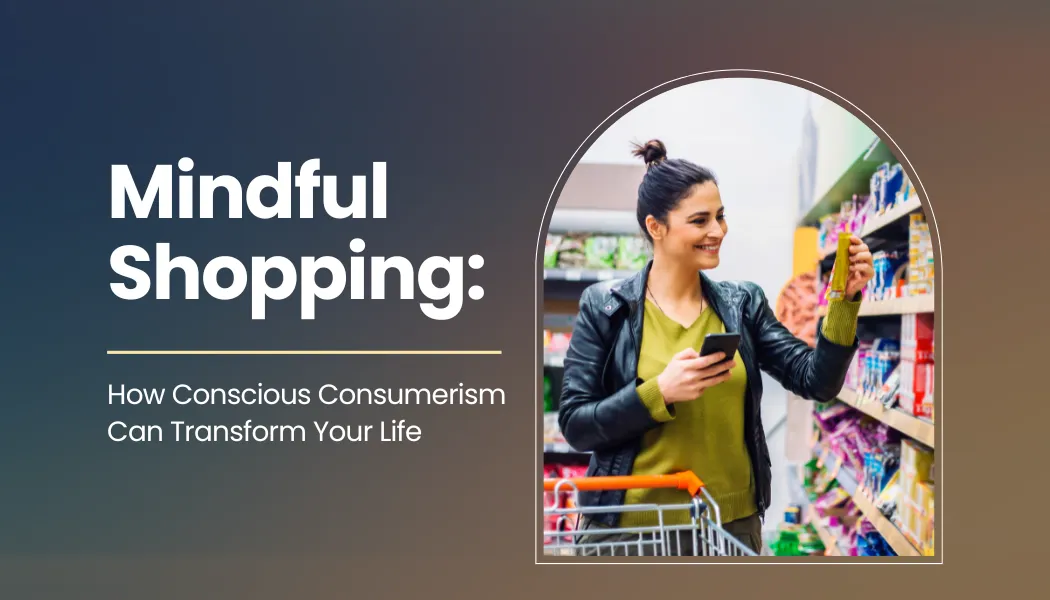Every time we buy something — from a morning coffee to a new pair of shoes — we cast a silent vote. We vote for the kind of world we want to live in, the kind of businesses we support, and the kind of impact we leave behind. Shopping may seem like a simple act of convenience or necessity, but in truth, it’s a powerful form of self-expression and social influence.
Mindful shopping, also known as conscious consumerism, is about being aware of the consequences of your purchases. It’s about slowing down the impulsive cycle of consumption and making choices that align with your values — whether those values are sustainability, fairness, quality, or minimalism.
In an age of fast fashion, one-click orders, and instant gratification, the mindful shopper stands out. They ask questions, seek transparency, and choose with intention. This article explores what mindful shopping really means, why it matters, and how each of us can cultivate a more conscious relationship with the way we consume.
Table of contents
- 1. The Rise of Mindful Shopping
- 2. The Psychology Behind Impulse Buying
- 3. What Does It Mean to Shop Mindfully?
- 4. The Environmental Impact of Our Purchases
- 5. How Mindful Shopping Benefits You Personally
- 6. How to Practice Mindful Shopping in Everyday Life
- 7. The Mind-Body Connection: How Shopping Affects Your Mood
- 8. Conscious Consumption Beyond the Store
- 9. Teaching Mindfulness Through Shopping
- 10. The Role of Brands and Businesses
- 11. Overcoming Common Challenges in Mindful Shopping
- 12. The Economic Ripple Effect of Conscious Choices
- 13. Real-Life Stories of Mindful Consumers
- 14. Mindful Shopping and the Global Future
- 15. From Shopping to Living Mindfully
- 16. Steps to Start Your Mindful Shopping Journey Today
- 17. The Ripple of Mindful Shopping: Changing the World One Cart at a Time
- Conclusion: Choosing With Heart, Living With Purpose
1. The Rise of Mindful Shopping
The global marketplace has transformed dramatically over the last two decades. Online retail giants have made shopping easier than ever before, but this convenience comes at a cost — to the environment, to workers, and often, to our own well-being.
Yet, in recent years, a quiet revolution has begun. Shoppers are waking up to the realization that “cheap” often means “someone else pays the price.” Consumers are becoming more informed and intentional about what they buy, leading to the rise of mindful shopping movements across the world.
- Eco-conscious brands are gaining traction, offering sustainable packaging, ethical sourcing, and fair wages.
- Secondhand and thrift markets have become mainstream, especially among younger generations who value uniqueness and waste reduction.
- Local artisans and small businesses are being rediscovered for their craftsmanship and authenticity.
This shift isn’t just about buying differently — it’s about thinking differently.
2. The Psychology Behind Impulse Buying
To understand mindful shopping, we must first understand its opposite: impulse buying.
Our brains are wired for immediate rewards. The small rush of dopamine we get when clicking “add to cart” mimics the same chemical pathways associated with pleasure and excitement. Retailers know this, and they design experiences — from targeted ads to flash sales — to keep us hooked.
A few psychological triggers that fuel overconsumption include:
- Scarcity Effect: “Only 2 left in stock!” makes us believe we’ll miss out.
- Social Proof: “10,000 people bought this today!” creates pressure to conform.
- Convenience Illusion: One-click checkouts make spending feel effortless.
- Emotional Substitution: Shopping as a way to fill emotional voids like boredom or stress.
Mindful shopping interrupts this automatic process. It introduces a pause — a conscious breath — between desire and decision.
3. What Does It Mean to Shop Mindfully?
Mindful shopping is not about deprivation. It’s not about never buying new things or feeling guilty for wanting something nice. Instead, it’s about presence and awareness in the act of consumption.
Here are the key principles of mindful shopping:
- Intention: Why am I buying this? Do I need it, or do I just want it?
- Awareness: What impact will this product have on the environment, people, and my own well-being?
- Quality over Quantity: Investing in fewer, higher-quality items that last longer.
- Ethical Consideration: Supporting brands that respect fair labor, sustainable sourcing, and animal welfare.
- Local Support: Choosing to buy from local producers and small businesses when possible.
- Minimal Waste: Reducing packaging waste, choosing reusable options, and recycling responsibly.
Mindful shopping is a lifestyle, not a limitation. It empowers us to make decisions rooted in purpose rather than habit.
4. The Environmental Impact of Our Purchases
Every product has a hidden footprint — from the resources used to make it, to the emissions from transporting it, to the waste left behind when it’s discarded.
Let’s consider a few examples:
- Fast Fashion: Produces 10% of the world’s carbon emissions and 20% of global wastewater. Most clothes end up in landfills within a year.
- Electronics: The average smartphone generates over 80 kilograms of CO₂ in its lifetime, and e-waste is now one of the fastest-growing waste streams globally.
- Food Choices: Imported foods require massive transport emissions; single-use plastics and unsustainable farming practices harm ecosystems.
When we buy with awareness — opting for recycled materials, fair-trade products, or local produce — we reduce this invisible footprint. One small conscious choice, multiplied by millions, can change the system.
5. How Mindful Shopping Benefits You Personally
The benefits of conscious consumerism extend far beyond environmental impact. It positively affects your mental, emotional, and financial well-being.
- Less Stress: Clutter and overspending often lead to anxiety. Mindful shopping helps simplify your life.
- Better Finances: You spend less on impulse buys and more on things that truly add value.
- Increased Gratitude: When you choose intentionally, you appreciate your possessions more.
- Enhanced Self-Control: You become less reactive to trends and marketing pressure.
- Higher Satisfaction: Quality purchases bring lasting joy, unlike the fleeting thrill of a bargain.
In essence, mindful shopping cultivates a healthier relationship with money, material goods, and yourself.
6. How to Practice Mindful Shopping in Everyday Life
Mindful shopping doesn’t happen overnight. It’s a practice — one that grows stronger with awareness and repetition. Here are practical steps to help you begin:

Step 1: Pause Before Purchasing
Before buying, take a few deep breaths and ask yourself:
- Do I truly need this?
- Can I borrow, repair, or reuse something instead?
- Will this item still bring me joy a month from now?
Step 2: Research Brands
Look into a company’s ethics, sustainability reports, and supply chain transparency. Many apps like Good On You or DoneGood rate brands based on environmental and social responsibility.
Step 3: Choose Quality
Opt for durable, timeless designs over trendy, disposable items. A $100 jacket that lasts 10 years is cheaper in the long run than a $25 one that lasts one season.
Step 4: Embrace Minimalism
Adopt the mantra: Less but better. Learn to declutter, donate, and repair rather than replace.
Step 5: Support Local and Small Businesses
Your money has more meaning when it stays within your community. It supports real people rather than faceless corporations.
Step 6: Use a Shopping List
Avoid impulse buying by keeping a list of what you genuinely need and sticking to it.
Step 7: Buy Secondhand or Upcycled
Vintage stores, swap meets, and online thrift platforms offer unique, affordable, and eco-friendly alternatives.
7. The Mind-Body Connection: How Shopping Affects Your Mood
Shopping triggers emotional responses that can either uplift or drain you. While occasional retail therapy can bring comfort, habitual or mindless consumption often leads to guilt and dissatisfaction.
Neuroscience reveals that intentional spending — on experiences, ethically-made goods, or gifts for others — releases more sustainable happiness hormones like serotonin and oxytocin. On the other hand, impulsive or excessive spending activates short-lived dopamine spikes followed by emotional crashes.
Mindful shopping transforms this cycle. It allows you to experience genuine joy in purchasing something that aligns with your values, meets a real need, and contributes positively to your world.
8. Conscious Consumption Beyond the Store
Mindful shopping extends beyond physical purchases. It applies to everything we consume — content, information, relationships, and even digital products.
Consider your online behavior:
- Are you buying apps or subscriptions you rarely use?
- Are you doomscrolling through ads that make you want more?
- Are you consuming digital content that nourishes or depletes your mental health?
Being mindful of your digital consumption is as important as your physical purchases. Unsubscribe from what doesn’t serve you, curate your feeds, and make your attention — your most valuable currency — count.
9. Teaching Mindfulness Through Shopping
Parents, teachers, and community leaders have a unique opportunity to model mindful shopping for the next generation.
Simple ways to teach this include:
- Taking children to local farmers’ markets to show where food comes from.
- Explaining the difference between needs and wants.
- Encouraging DIY repairs or upcycling old items.
- Practicing gratitude before buying — acknowledging the effort behind every product.
When kids see shopping as an act of awareness rather than accumulation, they grow into adults who buy less but value more.
10. The Role of Brands and Businesses
Mindful shopping doesn’t stop with consumers — it starts with companies. Many forward-thinking brands are redefining success by integrating sustainability, transparency, and purpose into their business models.
- Patagonia donates profits to environmental causes and encourages repair over replacement.
- Allbirds and Veja create eco-friendly footwear using natural materials.
- The Body Shop and Lush have long championed cruelty-free products and ethical sourcing.
As conscious demand grows, more brands are realizing that doing good is good business. The rise of B-Corporations — companies certified for their social and environmental performance — proves that profitability and purpose can coexist.
By supporting these brands, consumers send a powerful message: responsibility sells.
11. Overcoming Common Challenges in Mindful Shopping
It’s easy to embrace mindful shopping in theory, but challenges often arise in practice.
- Cost Barriers: Ethical and sustainable products sometimes cost more. The key is to buy less, but better — investing in durability and longevity.
- Limited Access: Not all areas have local or eco-conscious options. Online ethical marketplaces can bridge that gap.
- Temptation and Marketing Pressure: Unsubscribe from promotional emails and unfollow accounts that encourage impulsive spending.
- Time Constraints: Researching brands takes time initially, but becomes second nature over time.
Remember, perfection is not the goal — progress is. Even small shifts in habits can lead to meaningful change.
12. The Economic Ripple Effect of Conscious Choices
Every purchase you make supports a supply chain — from raw material producers to factory workers to logistics providers. By buying mindfully, you help redirect economic power toward more ethical and sustainable systems.
Supporting a local artisan means more money stays in your community. Choosing fair-trade coffee ensures farmers are paid fairly. Purchasing recycled goods helps create demand for circular economy models that minimize waste.
When millions of people shop mindfully, industries are forced to adapt. The growing success of eco-friendly startups and the rise of corporate sustainability programs are direct results of consumer demand.
13. Real-Life Stories of Mindful Consumers
Across the world, individuals are proving that conscious consumerism isn’t just an idea — it’s a movement.
- Amira from Amsterdam transitioned from fast fashion to capsule wardrobe living. She owns fewer than 40 pieces of clothing, yet says she’s “never felt more stylish or free.”
- David from Kenya runs a small local soap brand using recycled cooking oil and natural fragrances, empowering local women artisans in the process.
- Sophie and Max in Australia built a zero-waste home by buying secondhand furniture, composting, and supporting local organic farms.
Their stories remind us that mindful shopping is deeply personal — and universally transformative.
14. Mindful Shopping and the Global Future
The conscious consumer movement is shaping the future of the global economy. By 2030, sustainability is expected to be a key differentiator for successful brands.

Reports from McKinsey and Deloitte show that over 60% of Gen Z and Millennials prefer buying from purpose-driven brands. Many are even willing to pay more for products that are ethical and eco-friendly.
This generational shift signals hope. The future marketplace will likely be more transparent, equitable, and circular — where waste is minimized, workers are valued, and products are made to last.
As technology evolves, innovations like blockchain traceability, eco-labeling, and biodegradable packaging will make it even easier to make mindful choices.
15. From Shopping to Living Mindfully
Mindful shopping is just one branch of a larger tree: mindful living.
When you start to shop consciously, you naturally begin to eat, move, and communicate more mindfully too. It’s a ripple effect — awareness in one area enhances awareness in all others.
Soon, your focus shifts from acquiring more to experiencing more. You value presence over possessions, connection over consumption. That’s when true contentment begins — not in owning, but in being.
16. Steps to Start Your Mindful Shopping Journey Today
If you’re ready to make a change, here’s how to begin right now:
- Do a Closet or Pantry Audit: See what you already own — you might be surprised how much you have.
- Identify Core Values: Is it sustainability? Fair trade? Minimalism? Let your values guide purchases.
- Set an Intention for Each Month: For example, “This month, I’ll only buy secondhand clothes.”
- Track Spending: Awareness begins with observation. Use a budgeting app or notebook.
- Celebrate Small Wins: Every conscious purchase counts.
Over time, you’ll notice a shift — fewer regrets, more gratitude, and a deeper sense of fulfillment.
17. The Ripple of Mindful Shopping: Changing the World One Cart at a Time
Imagine a world where every product told a story of care, not exploitation; sustainability, not waste. Imagine if every consumer paused to ask, “Who made this? What impact did it create?”
That world isn’t far away — it begins with you.
Mindful shopping isn’t about perfection. It’s about progress, compassion, and awareness. It’s about realizing that every purchase, no matter how small, has the power to influence global change.
As mindfulness spreads from meditation cushions to supermarket aisles, we’re witnessing a profound cultural shift — from unconscious consumption to conscious living.
Conclusion: Choosing With Heart, Living With Purpose
Mindful shopping is not just a trend; it’s a transformation — a way of reconnecting with ourselves, our planet, and each other through the everyday act of buying.
When we align our consumption with our conscience, we redefine what it means to live well. We trade excess for essence, trends for timelessness, and greed for gratitude.
Every product you buy has a story. Choose the ones that tell a story you’re proud to be part of. Because in the end, mindful shopping isn’t about what’s in your cart — it’s about what’s in your heart.
